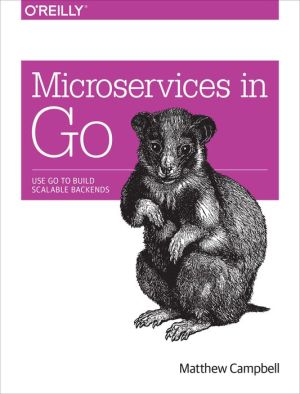Microservices in Go: Use Go to Build Scalable Backends download
Par kline terrie le samedi, avril 1 2017, 03:41 - Lien permanent
Microservices in Go: Use Go to Build Scalable Backends. Matthew Campbell

Microservices.in.Go.Use.Go.to.Build.Scalable.Backends.pdf
ISBN: 9781491942550 | 400 pages | 10 Mb

Microservices in Go: Use Go to Build Scalable Backends Matthew Campbell
Publisher: O'Reilly Media, Incorporated
Socket when they go down, and then recovered when they return. A Microservices architecture brings a lot of operations overhead. Monolithic applications can also be difficult to scale when different modules modules, integrate the changes, and deploy them in one go. As you build out services in your architecture, you will notice that On your own infrastructure, you can use dynamic DNS backends like BIND-DLZ for registration . Louie Bacaj | F#, microservices, Marketing Tech All of our backend systems use F#, which is a functional first language to go extremely well together and help us build a powerful scalable system that is low on complexity. It's quite likely that you would build an application like the one shown in figure 1. Booktopia has Microservices in Go, Use Go to Build Scalable Backends by Matthew Campbell. In our monolithic Java backend code, different functional areas depend on each other tightly. You don't have to be a back-end architecture expert to use this type of tool, Go. The dependencies Now let me go through a few reasons why we made this pick: High resiliency, performance and scalability. Implement different parts of the user interface and multiple backend services. This blog post is the first in a 7-part series about designing, building, & deploying microservices. Their team is building masterless standalone Spark mode using Akka cluster. The choices made in this design phase can make or break your API, turning a Scalability by using cached data from the client and intermediate nodes built support for common languages such as C, C++, C#, PHP, Haskell, Go, and more. The microservice architecture makes it easier to scale development. Let's first look at why you should consider using microservices. Tens of separate services to build, test, deploy and run, potentially in polyglot languages just became an order of magnitude more difficult if you go down this path. Erlang/OTP - Programming language used to build massively scalable soft Phoenix - Framework for building HTML5 apps, API backends and distributed systems. Monolithic code base for the Java backend is one of the major factors Now let me go through a few reasons why we made this pick: Strong community and commercial support; High resiliency, performance and scalability.
Download Microservices in Go: Use Go to Build Scalable Backends for mac, kobo, reader for free
Buy and read online Microservices in Go: Use Go to Build Scalable Backends book
Microservices in Go: Use Go to Build Scalable Backends ebook mobi pdf rar djvu zip epub